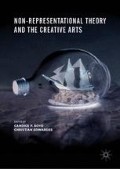Abstract
In this chapter, the practices of a General Assembly of Interested Parties (GAIP; Melbourne-based performance group) are presented through images of participating artists and a ‘gentle description’ oriented towards seven themes within non-representational theory: Sense, Movement, Relation, Self, Memory, Affect, and Experiment. The intention is not to treat these practices reductively but to highlight the ways in which an attunement to the non-representational is at the heart of the work. The chapter is infused throughout with references to philosophical thought that go only part way to elucidating what is intuitively felt and realised by performers through creative acts of improvisation.
Access this chapter
Tax calculation will be finalised at checkout
Purchases are for personal use only
References
Anderson, B. (2014). Encountering affect: Capacities, apparatuses, conditions. Farnham, UK: Ashgate.
Blackman, P. W. (2018, July 5). An artist walks through a doorway—An approach to liminal theatre [Facebook post]. Retrieved from https://www.facebook.com/notes/paul-william-blackman/an-artist-walks-through-a-doorway-an-approach-to-liminal-theatre/1646165432166814/.
Deleuze, G., & Guattari, F. (1987). A thousand plateaus: Capitalism and schizophrenia (B. Massumi, Trans.). Minneapolis: University of Minnesota Press.
Derrida, J. (1994). Specters of Marx: The state of the debt, the work of mourning, and the new international. New York, NY: Routledge.
GAIP (General Assembly of Interested Parties; n.d.). People. Retrieved from https://www.gaipsite.com.
Guattari, F. (1995). Chaosmosis: An ethico-aesthetic paradigm (P. Bains & J. Pefanis, Trans.). Bloomington: Indiana University Press.
Harman, G. (2002). Tool-being: Heidegger and the metaphysics of objects. Chicago, IL: Open Court.
Irigaray, L. (1992). An ethics of sexual difference (C. Burke & G. C. Gill, Trans.). Ithaca, NY: Cornell University Press.
Lyotard, J.-F. (1992). The inhuman: Reflections on time (G. Bennington & R. Bowlby, Trans.). Stanford, CA: Stanford University Press.
Maddrell, A. (2013). Living with the deceased: Absence, presence, and absence-presence. Cultural Geographies,20, 501–522.
Manning, E. (2009). Relationscapes: Movement, art, philosophy. Cambridge: MIT Press.
Manning, E. (2014). Wondering the world directly—Or, how movement outruns the subject. Body and Society,20, 162–188.
Manning, E., & Massumi, B. (2014). Thought in the act: Passages in the ecology of experience. Minneapolis: University of Minnesota Press.
Massumi, B. (2002). Parables for the virtual: Movement, affect, sensation. Durham, NC: Duke University Press.
Massumi, B. (2011). Semblance and the event: Activist philosophy and the occurrent arts. Cambridge: MIT Press.
Nancy, J.-L. (2007). Listening (C. Mandell, Trans.). New York, NY: Fordham University Press.
Serres, M. (2008). The five senses: A philosophy of mingled bodies (I) (M. Sankey & P. Cowley, Trans.). London, UK: Continuum.
Thrift, N. (2008). I just don’t know what got into me: Where is the subject? Subjectivity,22, 82–89.
Trigg, D. (2012). The memory of place: A phenomenology of the uncanny. Athens: Ohio University Press.
Whitehead, A. N. (1978). Process and reality (Corrected ed.). New York, NY: The Free Press.
Williams, R. (1977). Marxism and literature. Oxford, UK: Oxford University Press.
Acknowledgements
To all the participants in a General Assembly of Interested Parties.
Special thanks to Campbell McKay for generously sharing literature on the memory of place and absence-presence.
Author information
Authors and Affiliations
Consortia
Corresponding author
Editor information
Editors and Affiliations
Rights and permissions
Copyright information
© 2019 The Author(s)
About this chapter
Cite this chapter
Boyd, C.P. et al. (2019). Where Does ‘Your’ Space End and the Next Begin? Non-Representational Geographies of Improvised Performance. In: Boyd, C.P., Edwardes, C. (eds) Non-Representational Theory and the Creative Arts. Palgrave Macmillan, Singapore. https://doi.org/10.1007/978-981-13-5749-7_11
Download citation
DOI: https://doi.org/10.1007/978-981-13-5749-7_11
Published:
Publisher Name: Palgrave Macmillan, Singapore
Print ISBN: 978-981-13-5748-0
Online ISBN: 978-981-13-5749-7
eBook Packages: Social SciencesSocial Sciences (R0)

